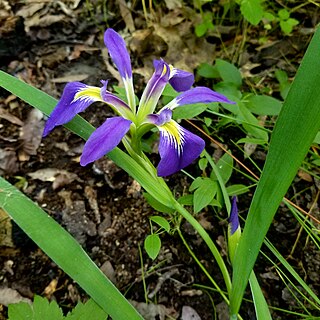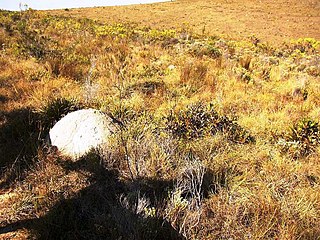
Drosera peltata, commonly called the shield sundew or pale sundew, is a climbing or scrambling perennial tuberous species in the carnivorous plant genus Drosera. Among the tuberous sundews, D. peltata has the largest distribution, which includes eastern and western Australia, New Zealand, India, and most of Southeast Asia including the Philippines. The specific epithet is Latin for "shield shaped", a reference to the shape of the cauline leaves. It is either a single extremely variable species, or a complex of several closely related species of uncertain taxonomic boundaries. In Australia at least four forms have had or still have specific taxonomic recognition: Drosera peltata subsp. peltata, D. peltata subsp. auriculata, D. foliosa and D. gracilis.
Scleria afroreflexa is a species of flowering plant in the family Cyperaceae. It is endemic to Cameroon. It grows on mountain grasslands, including areas of grassland in forested regions. It is threatened by the deliberate burning of the grassland habitat. This plant was first collected in 1999.

Spartina densiflora is a species of grass known by the common name denseflower cordgrass. It has been reclassified as Sporobolus montevidensis after a taxonomic revision in 2014, but Spartina densiflora is still in common usage. It is native to the coastline of southern South America, where it is a resident of salt marshes. It is also known on the west coast of the North America and parts of the Mediterranean coast as an introduced species and in some areas a noxious weed. In California it is a troublesome invasive species of marshes in San Francisco Bay and in Humboldt Bay, where it was introduced during the 19th century from Chile in ballast.

Sporobolus foliosus is a species of grass known by the common name California cordgrass. It was reclassified from Spartina foliosa after a taxonomic revision in 2014. It is native to the salt marshes and mudflats of coastal California and Baja California, especially San Francisco Bay. It is a perennial grass growing from short rhizomes. It produces single stems or clumps of thick, fleshy stems that grow up to 1.5 meters tall. They are green or purple-tinged. The long, narrow leaves are flat or rolled inward. The inflorescence is a narrow, dense, spike-like stick of branches appressed together, the unit reaching up to 25 centimeters long. The lower spikelets are sometimes enclosed in the basal sheaths of upper leaves.
Scleria biflora is a plant in the family Cyperaceae. It grows as a tufted annual grass.
Scleria bracteata, the bracted nutrush, is a plant in the family Cyperaceae. It grows as a perennial climber.
Scleria dregeana is a plant in the family Cyperaceae. It grows as a perennial herb.
Scleria greigiifolia is a plant in the family Cyperaceae. It grows as a perennial herb.
Scleria iostephana is a plant in the family Cyperaceae. It grows as a stout perennial sedge up to 2 metres high.

Scleria mackaviensis is a plant in the family Cyperaceae. It grows as a tufted sedge.
Scleria mikawana is a plant in the family Cyperaceae. It grows as a tall, slender annual sedge.

Scleria reticularis, also known as the reticulated nutrush or netted nutrush, is a plant in the sedge family Cyperaceae.
Scleria robinsoniana is a plant in the nutrush genus Scleria of the sedge family Cyperaceae.

Iris brevicaulis is a species in the genus Iris, it is also in the subgenus Limniris and in the series Hexagonae. It is a rhizomatous perennial, from North America. It has bright green, glossy long leaves, a long zig-zagged stem and 3–6 flowers per stem, which are come in blue shades from violet-blue, to lavender, to purple-blue, to bright blue to blue, and pale blue.

Scleria triglomerata, also known as the whip nutrush, is a plant in the sedge family Cyperaceae.
Scleria vogelii is a plant in the sedge family Cyperaceae. It grows as a stout perennial.

Protea foliosa, also known as the leafy sugarbush, is a flowering plant of the genus Protea in the family Proteaceae which is endemic to the Cape Region of South Africa. In the Afrikaans language it is known as ruie-suikerbos.
Protea intonsa, also known as the tufted sugarbush, is a flowering plant of the genus Protea within the family Proteaceae, endemic to South Africa, where it is distributed from the eastern Swartberg and Kammanassie Mountains to the Baviaanskloof mountains. In Afrikaans it is known as klossie-suikerbos.
Protea vogtsiae, also known as the Kouga sugarbush, is a small flowering shrub of the genus Protea within the family Proteaceae, which is only found growing in the wild in the southern Cape Region of South Africa.








